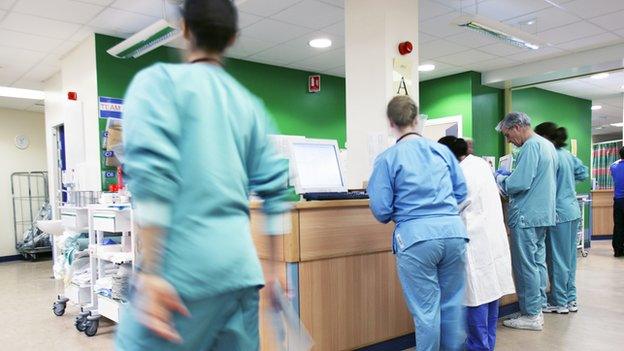A&E departments: More bad news
- Published
- comments

The latest news gives us an updated snapshot of the state of the NHS in different parts of the UK at a time when the service is under intense pressure and the subject of heated political debate.
The problem, as always, is that the figures are not in synch - Wales and Northern Ireland data for accident and emergency waiting times are for the month of December, while NHS England has come up with its latest weekly figures, up till Sunday, 11 January.
And what's happening in Scotland? Well we have no new figures since September and they will not be updated until February.
So what do we learn? There is confirmation, if it were needed, that the pressures on hospitals are being felt around the UK and posing challenges for both Westminster and the devolved administrations which run health.
Wales, like England, is recording the worst outcomes relative to four-hour waiting-time standards since current data-recording protocols were introduced over the last decade.
It is worth noting that in the week ending 11 January, the number of attendances at English A&E units fell slightly and the proportion seen within four hours was up by three percentage points compared with the previous week.
This was the week which saw a dozen hospitals declaring "major incidents" in a bid to clear the backlog in A&E and discharge as many patients as possible to free up beds.
But there will still major pressures on the service and the number of delayed transfers of patients was the highest this winter.
Ambulance changes
What is described as an "unprecedented increase in demand for ambulance services" has been given as a reason for a change in ambulance response policy in parts of England.
A row blew up in December after a leaked memo suggested that ambulance priorities might be changed because of pressure on the system.
An option under discussion was to reduce the number of conditions labelled as "Red 2", the second most urgent category. The government has now announced its plans.
The statement from Health Secretary Jeremy Hunt sets out a new a policy to be piloted in the South West of England and London.
The conditions branded "Red 1" and "Red 2" will remain the same, with a few actually moving up to "Red 1".
But the length of time before an ambulance is dispatched will be increased from 60 to 180 seconds.
The logic is to give more time to decide on priorities and avoid dispatches to cases which turn out to be less urgent than first believed.
Mr Hunt has made clear the changes have been made purely on clinical advice. NHS England and ambulance chiefs argue they will eliminate " inefficiencies" and "distortions" created by attempts to hit the eight-minute response time national target.
But Labour's response was that in the worst winter for the NHS in years it was the wrong time to experiment or relax operational standards.
A letter to the Health Secretary from Keith Willett, NHS England's director of acute care, suggests he would have liked to go further and downgrade some conditions from "Red 2" because those patients didn't derive clinical benefit from the arrival of an ambulance within eight minutes.
This was the thrust of the leaked memo last month. He acknowledges that the idea needs further discussion and could not be introduced short-term.
Reading between the lines, the Health Secretary seems to have decided that the changes to ambulance protocols flagged up in the December memo are too controversial.
What remains to be seen is whether the more limited shift in policy flagged up today becomes a political hot potato.
- Published16 January 2015